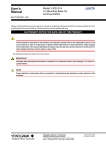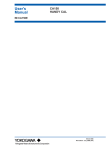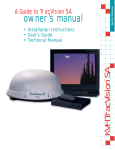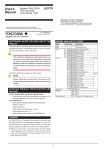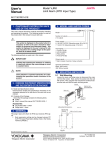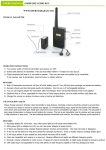Download Model VJP1 Pulse Repeater (Isolated Single-output
Transcript
User's Manual Model VJP1 Pulse Repeater (Isolated Single-output and Isolated Dualoutput Types) 2-9-32, Naka-cho Musashino-shi, Tokyo 180-8750 Japan Phone: +81-422-52-7179 Facsimile: +81-422-52-9802 Thank you for purchasing the JUXTA Signal Conditioner. Please read through this manual before use for correct handling. IM 77J01P01-01EN 1st Edition Aug. 2013 (YK) MODEL AND SUFFIX CODES CAUTIONARY NOTES FOR SAFE USE OF THE PRODUCT Model This User’s Manual should be carefully read before installing and operating the product. The following symbol is used on the product and in this manual to ensure safe usage. VJP1 Suffix codes -0 -0 □ □ -□ 6 7 Transmitter Power Supply -1 -2 □ □ 0 /□□ Output 1 configuration 2 Power supply This symbol is displayed on the product when it is necessary to refer to the User's Manual for information on personal and instrument safety. This symbol is displayed in the User's Manual to indicate precautions to avoid danger to the operator, such as an electric shock. Output-1 1 2 The following symbols are used only in this manual. Output-2 Note 3 1 2 Draws attention to essential information for understanding the operations and/or functions of the product. 3 N Options CHECKING PRODUCT SPECIFICATIONS AND PACKAGE *1 Operating range: 85-264 V *2 Operating range: 12-36 V (1) Checking the Model and Product Specifications Check that the model and specifications indicated on the nameplate attached to the main unit are as ordered. (2) Packaged Items Check that the package contains the following items: •• VJP1: 1 •• Tag number label: 1 •• User's Manual (this manual) GENERAL The VJP1 is a compact, plug-in pulse repeater that receives contact, voltage or current pulse from a field and converts them into isolated transistor-contact pulses or contactless AC switch pulse. 1 0 /SN [STYLE: S2] Description Pulse Repeater Always 0 Single Dual 100-240 V AC/DC (*1) 15-30V DC (*2) 12V DC±10% 24V DC±10% Open collector (30 V DC/200 mA) Open collector (30 V DC/30 mA) Contactless AC switch Open collector (30 V DC/200 mA) Open collector (30 V DC/30 mA) Contactless AC switch None Always 0 Blank: With socket Without socket Note When power of VJP1 is turned on/off, one pulse may be counted by the pulse input device which connects to the VJP1. 1. MOUNTING METHOD Note Insert/pull out the main unit into/from the socket vertically to the face of socket. Otherwise the terminals are bent and it may cause a bad contact. Wiring should be connected to the terminals on the socket of the product. The terminals for external connections are of M3 screws. Use crimp-on terminal lugs for connections to the terminals. •• Recommended cables: A nominal cross-sectional area of 0.5 mm2 or thicker for signal cables, and that of 1.25 mm2 or thicker for power cables. 1.1 Wall Mounting Loosen the main unit-fixing screw of the product and pull out the main unit from the socket. Fix the socket on the wall with screws. Next, insert the main unit into the socket and fasten the main unit with the main unit-fixing screw. Mounting Mounting Dimensions screws Unit: mm 29.5 or more 2-M4 or 22±0.2 2-ø4.5 or more Socket Transmitter PS+ 1 Transmitter + 3 − 4 59±0.3 Main unit Threaded hole for fixing the main unit Input When receiving When receiving current non-voltage contact pulse by running a signal or voltage pulse transmiter on an internal power supply Transmitter − 3 PS+ 1 + 3 − 4 Main unit-fixing screw Output-2 Pulse output 1.2 DIN Rail Mounting Insert a DIN rail into the upper part of the DIN rail groove on the rear of the socket, and then slide the slide lock at the lower part of the socket upwards until the socket is fixed into position as shown below 3 6 2 1 5 4 Power supply DIN rail 10 Push L+ (Rear of socket) 11 8 + – Output-1 Pulse output 9 8 7 11 10 N– GND 7 9 + – Note ●● Do not use output-2 for the single-output type. ●● The power line and input/output signal lines should be installed away from noise-generating sources. Other wise accuracy cannot be guaranteed. ●● The grounding resistance must be 100 Ω (JIS Class D grounding). The length and thickness of the grounding cable should be as short and thick as possible. Directly connect the lead from the ground terminal (terminal no. 8) of the product to the ground. Do not carry out daisy-chained inter-ground terminal wiring ●● Use of the product ignoring the specifications may cause overheating or damage. Before turning on the power, ensure the following: Power supply voltage and input signal value applied to the product should meet the required specifications. The external wiring to the terminals and wiring to ground are as specifications. ●● Do not operate the product in the presence of flammable or explosive gases or vapors. To do so is highly dangerous. ●● The product is sensitive to static electricity; exercise care in operating it. Before you operate the product, touch a nearby metal part to discharge static electricity. ●● For 15-30 V DC (±20%) power supply, as a safety measure, always install a circuit breaker (an IEC 60947-compatible product, 1 A, 30 V DC) in an easily accessible location near the instrument. Moreover, provide indication that the switch is a device for turning off the power to the instrument. DIN rail Slide look 2 5 Fit into here DIN rail When receiving voltage pulse by running a transmiter on an internal power supply 1.3 Mounting Using When using a multi-mounting base, see the User's Manual for VJCE (VJCE Mounting Base). 1.4 Using a Duct When using a wiring duct, install the duct at least 30 mm away from the top and bottom faces of the main unit. 2. INSTALLATION LOCATION •• Avoid the following environments for installation locations: Areas with vibration, corrosive gases, dust, water, oil, solvents, direct sunlight, radiation, a strong electric field, and/or a strong magnetic field, altitude of more than 2000m above sea level. •• If there is any risk of a surge being induced into the power line and/or signal lines due to lightning or other factors, a dedicated lightning arrester should be used as protection for both this converter and a field-installed device. •• Operating temperature/humidity range: 0 to 50C/5 to 90%RH (no condensation) 3. EXTERNAL WIRING WARNING Be sure to turn OFF the power supply before wiring to avoid the risk of electric shock. Use a tester or similar device to ensure that no power is being supplied to a cable to be connected. 2 IM 77J01P01-01EN 1st Edition 4. SETTING INPUT FILTER The input filter is used to suppress the influence of chattering noise or the like. Setting: Set the filter switch on the front panel of the signal conditioner to “ON.” (The factory default setting is “OFF”) •• The input filter, time constant (approx.10ms), is connected. However, the input frequency is limited to 100 Hz or less, and the pulse width is 3ms or more. “OFF” setting “ON” setting 5. MAINTENANCE The product starts running immediately when the power is turned on; however, it needs 10 to 15 minutes of warm-up before it meets the specified performance. 5.1 Calibration Apparatus •• A calibrator (Yokogawa CA150 or equivalent) 5.2 Calibration Procedure 1. Connect the instruments as shown below. First check the output-1 signal and then the output-2 signal. 3 Input + Calibrator – 3 6 2 1 5 4 Output-2 4 2 5 9 8 + Calibrator – 7 11 10 Power supply 10 L+ 11 N– 8 GND Output-1 7 9 + Calibrator – 2. Produce a rectangular pulse of any frequency from the calibrator to measure the value using a calibrator, then check that the frequency is output. 3 IM 77J01P01-01EN 1st Edition Blank Page





